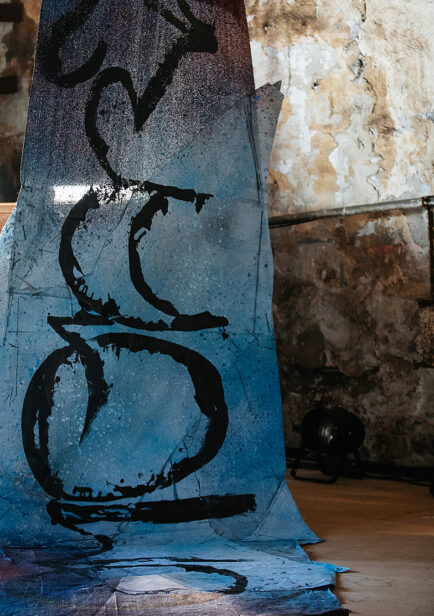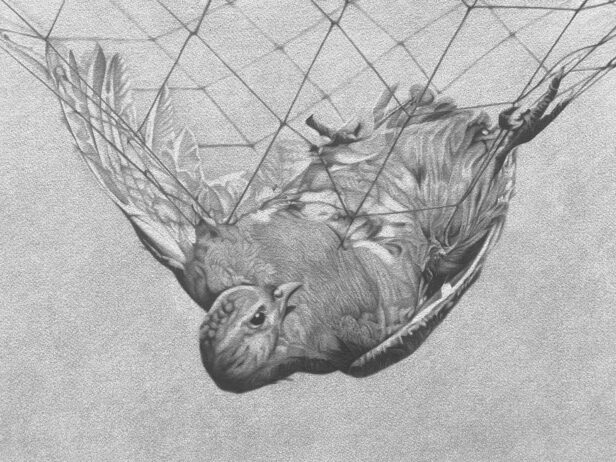Moderne Ruiner
HOMELESS OBJECTS
For over a decade, Elisabeth Engen, Astrid Findreng, and Grethe Britt Fredriksen, in the artistic constellation of Moderne Ruiner, have been studying the remnants of abandoned industrial facilities and deserted buildings. In the exhibition Hjemløse gjenstander (Homeless Objects) the artists show a strong attraction to deteriorating places, abandoned houses, factories, and other establishments that have lost the battle against rapid urban development and industrial upgrading. These recognizable environments and objects have been transformed into a comprehensive installation consisting of 3D animations, detailed architectural models, tableaus, and sculptural objects. The three artists have observed and documented how certain neighborhoods and places undergo rapid and extensive changes. The optimism surrounding the industry that contributed to the establishment of the welfare state in Norway has faded, and factories are closing down or relocating to make way for new apartment complexes, commercial spaces, and shopping centers. The exhibition specifically focuses on the two defunct industrial facilities, Bergs Machine (1947 – 2013) in Lilleby, Trondheim, and the original Marnar Bruk (1976 – 2011) in Mandal. When these facilities were shut down, it provided the artists with the opportunity to closely examine the empty spaces from the inside.
Using photographic material – where buildings and objects have been documented from all angles – the artists have digitally drawn detailed 3D models of the industrial facilities’ inventory. The modeling is not a reconstruction of reality but is interpreted through an observant eye where specific details are highlighted, abstracted, and transformed into something unique. In one of the exhibition rooms, the artists present an archive where a selection of physical models, which are small works in themselves, also serves as sketches for sculpting new, larger objects. How the artists work with format and scaling is an interesting aspect. From tiny details in miniature tableaus to the three wooden columns at the entrance, which loom almost four meters above the ground. Column!, Column!!, and Column!!! are inspired by the massive and now stripped-down steel structure of the Bergs Machine factory building, which now houses the Credo restaurant. In Moderne Ruiner’s construction, the architectural basic structure has been detached from its context and endowed with abstracted technical devices. Nevertheless, the sculptures bear an organic character both in form and choice of materials. One of the three columns features a prominent drum, a form that also serves as the starting point for the 3D animation Hjemløse gjenstander (Homeless Objects). The exhibition’s other objects are also designed with a distinct mechanical aesthetic, outlined through highly detailed technical drawings. Separated from their original environment, the objects appear as almost identifiable signs or symbols, with recognizable shapes but without any concrete function. The modernist motto Form follows function has been broken down, and the objects have become abstract sculptures. They have become our contemporary modern ruins, both sublime and picturesque, though in a different way than the remains of a cathedral in the twilight.
The environments we encounter in the exhibition are subject to a similar process. The buildings and objects decay, and when the context is gone, the abandoned, uninhabited areas are transformed into melancholic spaces and atmospheric landscapes. In the animated film Expirator, we are taken into the dim and mysterious world inside Marnar Bruk’s impregnation halls. The animation software used by the artists allows the “camera” to glide through the factory’s various rooms, showing a place that seems recently abandoned, with traces of the workers’ daily lives. Even though the premises have been empty for several years, no one returned to turn off the lights or to lower the heat. Marnar Bruk can be seen as a representation of how rapidly the decline in Norwegian factory employment occurred. Two years before the factory was established, industrial employment was at its peak. In 1974, 40% of the Norwegian workforce was employed in industry, while in 2008, it accounted for only 11% in comparison. Moderne Ruiner thus shows how time can transform a place and focus on what is so recent that it almost imperceptibly disappears. By removing the function from the form and eliminating the rationality and purpose of the objects, we become aware that the way we manage our society also means that recent history and knowledge can be lost.
Moderne Ruiner was established in 2009 and consists of Astrid Findreng (b. 1964), Grethe Britt Fredriksen (b. 1957), and Elisabeth Engen (b.1957). This is an ongoing collective project where the artists produce everything together. Moderne Ruiner has previously exhibited at venues such as the Nordnorsk Kunstnersenter in Svolvær, the Agder Centre for Contemporary Art, Babel Kunst, Østfold Centre for Contemporary Art, Tronhjems kunstforening, and Heimdal kunstforening.The three artists live and work in Trondheim. Moderne Ruiner received support for the exhibition from the Arts and Culture Norway, Billedkunstnernes vederlagsfond – BKV, Trondheim Municipality, Regionale prosjektmidler for visuell kunst og The Norwegian Association for Arts and Crafts – NK.
Bianca Hisse
LANDMARKS
The works exhibited at Forum Box are part of the larger research project Landmarks, which explores land demarcations, territorial struggles and language. The project encompasses sculptures, installations and live actions, and for the show at Forum Box it is presented through a textile piece and a video documentation of a performance, which premiered at this year’s Festspillene i Nord–Norge in Harstad.
The textile weaves together advertisement banners collected from public space, and hangs as a 7-meter long flag in the gallery. The piece is created in collaboration with visual artists Sarah Key (Brazil) and Terje Grimen (Norway). For this work, Key designed a typography based on pixação: a style of street tagging born in the peripheries of São Paulo. Pixação is a coded language, a type of performative writing on walls, facades, buildings and monuments, which is historically linked with acts of protest against repressive regimes. The calligraphy of pixação is often repetitive, quick-to-execute inscriptions, symbols or hieroglyphic characters in black and white. OIMOMARÃ, originally a word from Tupi-Guarani language, means “to survive in adverse times”.
In the video documentation we see five performers enacting different actions in public space. Their performative scores are based on theatrical games developed by Brazilian artist and activist Augusto Boal in his seminal work Theater of the Oppressed, as well as archival images, newspaper material and US Army field manuals. They appear and disappear in the landscape, performing a series of images inspired by military exercises, displays of authority and discipline, police control, resistance movements and collective actions.
Bianca Hisse (b. 1994, São Paulo, Brasil) lives and works in Oslo. She holds a Master in Visual Arts from Kunstakademiet i Tromsø (2019). Her works have been exhibited across Norway and internationally, including: Kiasma Museum of Contemporary Art, Finland (2023), Kunsthalle Recklinghausen, Germany (2023), Kunstnernes Hus, Norway (2020), MAR Museo, Argentina (2021). Her projects have also been included at the Mediterranea 19 Young Artists Biennial (San Marino), and BienalSur: International Biennial of Contemporary Art of South America (2021).
Magnhild Opdøl
WALKING BEYOND THE TREES
For the past few years I have worked with fragments from nature, often drawings based on photographs and found objects, but also using the actual fragments and photographs in my work. I draw because I’m afraid to forget, and through the drawing I collect the places, thoughts, time and situations, both from where I found the image or object, and the time spent drawing it. Then I puzzle the fragments together to create a complete landscape.
For my drawings I process the photographs according to basic compositional principles. The photographs are then used to create pencil drawings, often leaving only the main motif on a white or black surface. The pictorial approach is realistic, but the motif is presented without an eye for a realistic reproduction of the object. Primarily looking to evoke a feeling, the object-composition is a vehicle. The sculptural works goes through a similar process, and I often add or change the material to create new associations to the objects. For each work I use the medium that most fits the idea. Some come from real places, memories, stories and images, while others exist in some place in popular culture or a collective visual vocabulary.
Magnhild Opdøl (b. 1980) lives and works in Sunndal, Norway and is educated at the National College of Art and Design, Dublin (2002-2007) and at Nordiska Konstskolan in Kokkola (2000-2002). Opdøl works in the tension between naturalistically compelling drawing and cruel reality, and the works on paper spill out into the room with sculptural works and objets trouvés. From her studies to the present day, the search for possibilities to show the invisible or overlooked has been her ongoing motivation. Opdøl’s motives are often inspired by day-to-day life and daily human interventions into nature and objects around us. The beginning of a work is marked by stepping back and rediscovering something that has long been familiar but at the same time contains subtle references to art history. Recent exhibitions include: “Petrichor”, Haugesund Billedgalleri, NO (solo, 2023), “Med mjuke steg”, Møre og Romsdal Kunstsenter, NO (solo, 2023), “Drawing Time”, Royal Hibernian Academy, IRL (group, 2023-24), Trøndelagsutstillingen, NO and Vestlandsutstillingen, NO (group, 2023), “(alone at last)”, Galleri Box, Göteborg, SE (solo, 2021), “I almost forgot”, Galleri Ask, NO (solo, 2022), “we do not want to be us”, Norsk Skogmuseum, Elverum, NO (solo, 2021), “Holding my Breath”, Galleri Ö, Tjøtta, NO (solo, 2021) and “The last word”, Hå Gamle Prestegard, NO (solo, 2019).

Tonje Bøe Birkeland
THE CHARACTERS
The aim of THE CHARACTERS is to encapsulate an entire artistic practice. Since 2008 Tonje Bøe Birkeland has, through THE CHARACTERS, given women a position within the landscape while exploring the objectivity of history. In Birkland’s expeditions, female explorers are staged in Unknown Territory. Materials have been gathered from their journeys, yielding stories and installations with photography in large formats, text panels, and a suitcase for every traveller, together portraying Characters # I – V. The heroine moves in pristine territory: in front of her loom grand explorations; beneath her, history is formed. However, for all their expansive vistas and sublime experiences, expeditions come at a price, both in the past and today.
THE CHARACTERS demand physical presence as well as sensitivity for storytelling. Each project augments the gallery of personas of female heroines from the past, who, through narrative, fantasy, and photography, can fill a void in our history and reveal contemporary society’s challenges: globalized colonization on the one hand and the loss of the great adventure on the other. Each of The Characters shapes a meta-journey: that of the artist. The imagined female heroines have taken Tonje to the East Coast of Greenland, the Gobi Desert in Mongolia, and through the Inner Himalayas of Bhutan.
Tonje Bøe Birkeland (b. 1985, Bergen) received an MFA from Bergen Academy of Art & Design. In 2008 she started working with The Characters, aiming to encapsulate an entire artistic practice. For the past 15 years she has, through The Characters, given women a position within landscape while exploring the authenticity of history. While the romantic motives of the male wanderer have been well-documented, in Birkeland’s project, female explorers are staged in Unknown Territory. In front of the heroine looms grand exploration; beneath her, history is formed. In 2021 Birkeland published her second artist book The Characters: Character #V Bertha Bolette Boyd (1900-1985), The Bhutan Trilogy, Bergen Kjøtt Publishing. In 2023 the book has been on display at AbC Art Book Fair/Shanghai and Unfold/Shanghai. Recent solo shows include: The Characters, Character # V, Sølvberget galleri/Stavanger, The Characters, Nuuk Art Museum/Nuuk and The Characters, Fotografihuset/Oslo. Through The Characters Birkeland has been awarded The Victor Fellowship by the Hasselblad Foundation (2012) and silver in the Norwegian book design contest Årets Vakreste Bøker (2017).
In addition, Mediabox presents Qi Tan‘s videowork Silver Dragon: Read more



